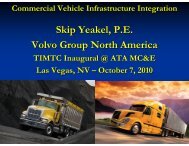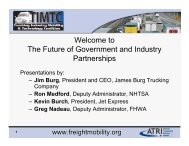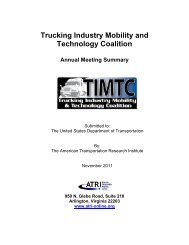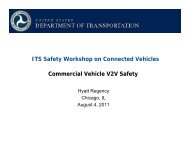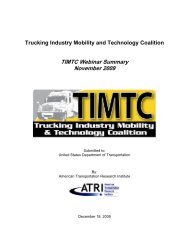The Truck Parking Shortage - Trucking Industry Mobility and ...
The Truck Parking Shortage - Trucking Industry Mobility and ...
The Truck Parking Shortage - Trucking Industry Mobility and ...
You also want an ePaper? Increase the reach of your titles
YUMPU automatically turns print PDFs into web optimized ePapers that Google loves.
<strong>The</strong> <strong>Truck</strong> <strong>Parking</strong> <strong>Shortage</strong>: A GrowingProblem for Drivers• Presentations by:– John Tompkins, Office of Freight Planning & Development,Minnesota DOT– Vern Keeslar, Senior Planner, InterPlan, Utah I-15 <strong>Truck</strong> <strong>Parking</strong>Project– Stephanie Klang, America’s Road Team Captain, Con-way<strong>Truck</strong>load• A copy of today’s presentation will be available on the TIMTC website atwww.freightmobility.org1 www.freightmobility.org
<strong>The</strong> TIMTC Mission:• To improve the knowledge base of both private <strong>and</strong> publicsector stakeholders of freight transportation issues <strong>and</strong>possible technology solutions• To ensure a working forum of industry stakeholders that cancoordinate existing <strong>and</strong> planned research initiatives2 www.freightmobility.org
3 www.freightmobility.org
John Tompkins, Freight Project ManagerOffice of Freight & Commercial Vehicle OperationsMinnesota Department of Transportation
Background Importance of this work Overview of TPAS Approach to detect parking availability TPAS performance Video demonstration Summary <strong>and</strong> next steps
MnDOT: overall project management <strong>and</strong>coordination ATRI : requirements, information, deliverysystems U of M team: development, deployment,evaluation of system performance, outreach Private sector information portal <strong>and</strong> in-cabinformation
Driver fatigue a contributing factor in heavytruck accidents◦ Leads to 40% truck accidents Minnesota: high correlation between overcapacityrest areas <strong>and</strong> truck crashes on theadjacent road segment (2007)
Drivers perceive parking shortages withoutadequate information (FHWA, 2002):◦ 89% for public rest area parking◦ 67% for commercial truck stops Hours of Service “Should I park illegally or continue to drive fatiguedto the next rest stop?”
T.P.A.S. Real-time parking information◦ Utilize parking capacity more efficiently◦ Inform commercial drivers of available nearbyparking
One approach todirectly detectingavailable parkingspaces Communicatesdetection occupancythrough Web,electronic signs <strong>and</strong>in-cab informationdisplay services
3D reconstruction ofparking spaceactivity. Multiple cameras Designed to preventproblems with sharpshadows, partialocclusion, <strong>and</strong> otherlighting changes
Deploy multi-cameracrank-down polesMultiple Camera views3D Reconstruction <strong>and</strong>alignmentzyx1 2 3456
Average Dusk-to-Dawn accuracy = 98.2%Average Daytime accuracy = 99.5%<strong>Parking</strong> DetectionPerformance over 5 Days
State ownedPrivate ownedTrailer CMS’s spaced 20 to 30RestminutesAreas accessible& about 2 milesforbeforeEasteachBoundresttrafficareaonInterstate 94Spunk Lake(16 stalls)Private stop(44 stalls)20 mi50 kmEnfield(18 stalls)Elm Creek(15 stalls)
Trailer CMS’s spaced 20 to 30minutes & about 2 miles beforeeach rest areaSpunk Lake(16 stalls)Private stop(44 stalls)Enfield(18 stalls)20 mi50 kmElm Creek(15 stalls)
Field installation of real-time parking detection system atfirst State owned <strong>Truck</strong> Rest Area implemented (Jan 2013).◦ Use lessons learned to implement other sites in spring <strong>and</strong>summer 2013◦ Sites will go ‘on-line’ incrementally as they are completedSystem will allow detailed evaluation of parking detectionsystem accuracy <strong>and</strong> robustnessNew tool to evaluate detailed parking behaviors <strong>and</strong>trends along critical interstate freight corridor 24/7Future: Extending capabilities for corridor parkingmanagement <strong>and</strong> safety
Federal Highway Administration Ted Morris, Doug Cook, Vassilios Morellas,Nikolaos PapanikolopoulosDept. of Computer Science, U of Minnesota Dan MurrayAmerican Transportation Research Institute
Questions?
Utah I-15 <strong>Truck</strong> <strong>Parking</strong> ProjectATA, TIMTC, & ATRI ConferenceOctober 21, 2013 Orl<strong>and</strong>o, FloridaVern Keeslar, AICPInterPlan Co.7719 South Main StreetMidvale, UT 84047vern@interplanco.com801-307-3400
Utah I-15 <strong>Truck</strong> <strong>Parking</strong> ProjectPresentation by Vern Keeslar, AICP, Senior Planner, InterPlan Co.Utah’s I-15 <strong>Truck</strong> <strong>Parking</strong> Project1. Congressional Focus on <strong>Truck</strong> <strong>Parking</strong>2. Utah’s I-15 <strong>Truck</strong> <strong>Parking</strong> Project3. Utah’s I-15 <strong>Truck</strong> Safety Data4. Utah’s I-15 <strong>Truck</strong> Driver <strong>Parking</strong> Survey5. Focus Groups – <strong>Truck</strong> Drivers <strong>and</strong> <strong>Truck</strong> Stop Managers6. Estimating Long Term <strong>Truck</strong> <strong>Parking</strong> Supply/Dem<strong>and</strong>7. Proposed Solutions to Increasing I-15 <strong>Truck</strong> <strong>Parking</strong>8. Summary
Utah I-15 <strong>Truck</strong> <strong>Parking</strong> ProjectCongressional Focus on <strong>Truck</strong> <strong>Parking</strong>• <strong>The</strong> Transportation Equity Act for the 21st Century (TEA-21) was enactedJune 9, 1998 as Public Law 105-178• Section 4027 of TEA-21 required the following:‣ Study to determine the location <strong>and</strong> quantity of parking facilities atcommercial truck stops/travel plazas <strong>and</strong> public rest areas that could beused by motor carriers to comply with Federal hours of service rules‣ Study to include: Inventory of current facilities serving the National Highway System Analysis of where shortages exist <strong>and</strong> are projected to exist A plan to reduce the shortages
Utah I-15 <strong>Truck</strong> <strong>Parking</strong> Project• In 1999, the Federal Highway Administration (FHWA) requested feedbackon how to best conduct the study as required in Section 4027 of TEA-21• <strong>The</strong> first step of the study was to administer <strong>and</strong> evaluate a national truckdriver survey about driver parking needs <strong>and</strong> the adequacy of currentparking facilities‣ <strong>The</strong> survey was conducted on location in 7 states <strong>and</strong> was also mailedto commercial truck stops in 27 states‣ More than 2,000 surveys were collected‣ Utah was not surveyed on location or by mail• <strong>The</strong> study was published in March 2002• <strong>The</strong> Safe, Accountable, Flexible, Efficient Transportation Equity Act: ALegacy for Users (SAFETEA-LU) was enacted August 10, 2005 as PublicLaw 109-59‣ Section 1305 of SAFETEA-LU created the <strong>Truck</strong> <strong>Parking</strong> Facilitiespilot program that provides funding to address the shortage of longtermparking for commercial vehicles on the National Highway System
Utah I-15 <strong>Truck</strong> <strong>Parking</strong> ProjectUtah’s I-15 <strong>Truck</strong> <strong>Parking</strong> Project• UDOT submitted an application for the <strong>Truck</strong> <strong>Parking</strong> Initiative grant inFebruary 2008• FHWA awarded UDOT $545,000 in August 2010• UDOT formed a Project Management Committee in September 2010consisting of representatives from the Utah <strong>Truck</strong>ing Association, UtahHighway Safety Office, FHWA Utah Division, UDOT’s Planning Group, MotorCarrier Division, <strong>and</strong> Traffic Operations Center
Utah I-15 <strong>Truck</strong> <strong>Parking</strong> ProjectUtah’s I-15 <strong>Truck</strong> Safety Data• Crashes involving trucks (class 8 <strong>and</strong>above)‣ While 9% of all crashes involved atruck, trucks represent 12% of allvehicle miles traveled (VMT) inUtah‣ <strong>Truck</strong> crashes on I-15 involveddrivers from 50 states <strong>and</strong> 7Canadian Provinces‣ <strong>The</strong> statewide average truck crashrate is 11.6 crashes per 100 millionVMT‣ <strong>The</strong> truck crash rate on I-15 is 13.6crashes per million VMT <strong>and</strong>consistent with the expected crashrate
Utah I-15 <strong>Truck</strong> <strong>Parking</strong> Project• 98% of truck crashes caused bydriver fatigue occurred greater than5 miles away from the closestUDOT rest area• 44% of truck crashes caused bydriver fatigue occurred greater than5 miles away from the closest truckparking facility (commercial truckstop, rest area, <strong>and</strong> port-of-entry)• According to a study by the FederalMotor Carrier Safety Administrationthe average cost per truck crash is$101,000 in 2010 USD• <strong>Truck</strong> driver fatigue related crasheson I-15 in Utah cost an average of$1 million per year
Utah I-15 <strong>Truck</strong> <strong>Parking</strong> ProjectUtah’s I-15 <strong>Truck</strong> Driver <strong>Parking</strong>Survey• Survey goal was to use the nationalsurvey, apply locally, <strong>and</strong> determine theanswers to four questions:‣ How truck drivers plan for <strong>and</strong>address their parking needs‣ How truck drivers select when,where <strong>and</strong> at which facilities theypark‣ What truck drivers think of theadequacy of current parkingfacilities‣ How truck drivers would like toreceive information about truckparking availability
Utah I-15 <strong>Truck</strong> <strong>Parking</strong> ProjectSurvey Process• Developed survey <strong>and</strong> methodology to match National effort for comparisonpurposes‣ 24 total questions‣ 9 questions were same as the National Survey‣ 9 questions were modified from National Survey‣ 6 questions were different from National Survey• Local questions included‣ What type of communication technology do you currently have availablein your truck?‣ Is your trailer refrigerated?‣ Where did you start driving from today?‣ Where is home base?
Utah I-15 <strong>Truck</strong> <strong>Parking</strong> ProjectSurvey Methodology• Statistically valid sample size determined by the average daily combinationtruck traffic along I-15 in Utah‣ 383 at the 95% confidence level‣ 433 surveys were collected from drivers representing 224 cities in 35states <strong>and</strong> 5 Canadian ProvincesSurvey Distribution <strong>and</strong> Collection• Survey done at 8 locations between February <strong>and</strong> June 2011‣ 11-2 pm (204 surveys collected)‣ 4-8 pm (226 surveys collected)• <strong>Truck</strong> drivers were approached using st<strong>and</strong>ard protocol• Participation was voluntary to complete the seven page, paper-based surveytaking approximately 12-15 minutes to completeSurvey Lessons Learned• Separate truck terminals from warehouses as truck parking locations• Electronic logs reduced participation in our time-consuming survey• Value in face to face interaction (improved input <strong>and</strong> comments)
Utah I-15 <strong>Truck</strong> <strong>Parking</strong> ProjectSurvey Locations• Ogden, Pilot Flying J (70)• Salt Lake City, SAPP Brothers (61)• Salt Lake City, Pilot Flying J (39)• Springville, Pilot Flying J (50)• Nephi, Pilot Flying J (58)• Beaver, Ernie’s <strong>Truck</strong> Plaza (47)• Parowan, TA Travel Center (57)• Cedar City, Love’s Travel Stop (51)
Utah I-15 <strong>Truck</strong> <strong>Parking</strong> ProjectI-80/I-15 Corridor: Southern California Freight Connection• I-15 provides a directlink between I-80 <strong>and</strong>Southern California• South of Salt LakeCity, most freight onI-15 is east/west, notnorth/south• Like Sacramento inNorthern California,Barstow is the freightcrossroads ofSouthern California• I-15’s relationship toI-80 is critical tounderst<strong>and</strong>ing the I-15truck parking shortage
Utah I-15 <strong>Truck</strong> <strong>Parking</strong> Project
Utah I-15 <strong>Truck</strong> <strong>Parking</strong> Project
Utah I-15 <strong>Truck</strong> <strong>Parking</strong> Project
Utah I-15 <strong>Truck</strong> <strong>Parking</strong> ProjectHighlights of Survey ResponsesSection A: Background• 32% drive for a larger-sized carrier (carrier with more than 100 power units)• 28% are independent owner/operator (1 power unit)• 79% drive by themselves• 38% have a refrigerated trailer• 95% were long haul drivers• Based on driver interviews, more than half were connecting to or from I-80
Utah I-15 <strong>Truck</strong> <strong>Parking</strong> ProjectHighlights of Survey ResponsesSection B: <strong>Parking</strong> Patterns <strong>and</strong> Preferences• 97% decide themselves where to park• 66% make that decision while they are driving• Why do truckers park on ramps <strong>and</strong> shoulders?‣ 82% no empty spaces at truck stops or rest areas‣ 72% no nearby parking facility‣ 33% not aware of available parking in nearby truck stops or rest areas• Top five important features at truck stops‣ Restrooms‣ Convenience to highway‣ Showers‣ Fuel‣ Restaurant
Utah I-15 <strong>Truck</strong> <strong>Parking</strong> ProjectHighlights of Survey ResponsesSection C: <strong>Parking</strong> Solutions• What type of real-time information on truck parking availability would help?‣ 69% want location of parking facilities‣ 56% want to know features (food, fuel, showers)‣ 51% want number of truck parking spaces• What communication technology is available in your truck?‣ 84% CB radio‣ 82% a mobile phone‣ 57% on-board navigation equipment (GPS)‣ 45% personal computer, laptop or notebook
Utah I-15 <strong>Truck</strong> <strong>Parking</strong> ProjectHighlights of Survey ResponsesSection C: <strong>Parking</strong> Solutions (continued)• Driver preference to receive information about availability of truck parking‣ Variable message sign (VMS)‣ Paper map of truck parking locations‣ Highway advisory radio (HAR)• Possible truck parking improvements to I-15‣ Build more truck stop parking spaces‣ Build more rest area parking spaces‣ Stop enforcement from waking drivers
Utah I-15 <strong>Truck</strong> <strong>Parking</strong> ProjectHighlights of Survey ResponsesSection D: Information About This Trip• How far are you away from home base?‣ 62% less than 1,000 miles‣ 31% 1,000 to 2,000 miles‣ 9% 2,000 miles or more• Where did you last park your truck to sleep?‣ 65% last parked to sleep at a truck stop‣ 12% have not yet parked to sleep‣ 10% last parked to sleep at a loading bay/terminal‣ 9% last parked to sleep at a rest area
Utah I-15 <strong>Truck</strong> <strong>Parking</strong> ProjectHighlights of Survey ResponsesSection D: Information About This Trip (continued)• Where is the next place you plan to park your truck to sleep?‣ 65% next place to sleep is at a truck stop‣ 14% home‣ 13% next place to sleep is at a loading bay/terminal‣ 7% next place to sleep is at a rest area• Comments about long-term truck parking along I-15 in Utah by surveyrespondents‣ 70% of truck drivers did not write open ended comments‣ Quotes from truck drivers Call-in number – illegal. Text to mobile phone – illegal. Call to mymobile phone – illegal. (while driving) Reopen closed rest areas Need parking spaces for oversized loads
Utah I-15 <strong>Truck</strong> <strong>Parking</strong> ProjectFocus Groups – <strong>Truck</strong> Drivers <strong>and</strong> <strong>Truck</strong> Stop Managers• <strong>Truck</strong> Drivers‣ Develop truck parking map with the following information: Exit numbers Locations Number of parking spaces available Name/br<strong>and</strong> of truck stops Using durable, non-laminated material‣ Create Smartphone app to inform truck drivers of commercial truckstops <strong>and</strong> rest areas with the following information: <strong>Parking</strong> availability Fuel prices Services <strong>and</strong> amenities Hours of operating Types of parking available‣ Accurate <strong>and</strong> up-to-date information
Utah I-15 <strong>Truck</strong> <strong>Parking</strong> Project• Commercial <strong>Truck</strong> Stop Managers‣ Agreed that finding available truck parking is a challenge for manydrivers‣ Expansion does not seem feasible or profitable‣ Motivation to consider expansion: Compensation (tax breaks or incentives) Guarantee of return on investment Assistance in maintaining the property‣ Participants do not track parking availability at their facility Too difficult due to constant movement
Utah I-15 <strong>Truck</strong> <strong>Parking</strong> ProjectEstimating Long Term <strong>Truck</strong> <strong>Parking</strong> Supply/Dem<strong>and</strong>Supply• Identified long-term truck parking spaces at commercial truck stops, publicrest areas, <strong>and</strong> ports-of-entry• Divided the I-15 corridor into three segments‣ Northern Utah (mostly rural)‣ Wasatch Front (mostly urban)‣ South/Central Utah (mostly rural)• Determining how we account for other parking supply‣ Local streets‣ <strong>Truck</strong> terminals/warehouses‣ Vacant parking lots (such as closed big box stores <strong>and</strong> truck stops)‣ Big box stores (such as Wal-Mart)‣ Park-n-ride lots
Utah I-15 <strong>Truck</strong> <strong>Parking</strong> ProjectUtah I-15 Existing <strong>Truck</strong> <strong>Parking</strong>Supply• 31 commercial truck stops‣ 1,693 parking spaces• 8 public rest areas‣ 94 parking spaces• 4 ports-of-entry‣ 120 parking spaces• 2 commercial retail location‣ 40 parking spaces• 45 total locations‣ 1,947 parking spaces
Utah I-15 <strong>Truck</strong> <strong>Parking</strong> ProjectUtah I-15 Future <strong>Truck</strong> <strong>Parking</strong>Supply• 31 commercial truck stops‣ 1,693 parking spaces• 8 public rest areas‣ 158 parking spaces• 4 ports-of-entry‣ 120 parking spaces• 2 commercial retail location‣ 40 parking spaces• 45 total locations‣ 2,031 parking spaces• Only 84 additional truck parkingspaces planned
Utah I-15 <strong>Truck</strong> <strong>Parking</strong> ProjectDem<strong>and</strong>• Calculated using ratio of drive time versus parking time• Used Freight Analysis Framework (FAF3) to form 16 districts• 2007 <strong>and</strong> 2040 truck volume forecasts• <strong>Truck</strong> volumes adjusted using origin <strong>and</strong> destination data from Utah survey• Calculated long-haul versus short-haul separately• Travel time contours by InterPlan using ESRI Network Analyst with NationalHighway Planning Network
Utah I-15 <strong>Truck</strong> <strong>Parking</strong> Project
Utah I-15 <strong>Truck</strong> <strong>Parking</strong> Project
Utah I-15 <strong>Truck</strong> <strong>Parking</strong> Project
Utah I-15 <strong>Truck</strong> <strong>Parking</strong> Project
Utah I-15 <strong>Truck</strong> <strong>Parking</strong> Project
Utah I-15 <strong>Truck</strong> <strong>Parking</strong> Project
Utah I-15 <strong>Truck</strong> <strong>Parking</strong> Project
Utah I-15 <strong>Truck</strong> <strong>Parking</strong> Project
Utah I-15 <strong>Truck</strong> <strong>Parking</strong> Project
Utah I-15 <strong>Truck</strong> <strong>Parking</strong> Project
Utah I-15 <strong>Truck</strong> <strong>Parking</strong> Project
Utah I-15 <strong>Truck</strong> <strong>Parking</strong> ProjectSupply/Dem<strong>and</strong> Ratios
Utah I-15 <strong>Truck</strong> <strong>Parking</strong> ProjectProposed Solutions for Increasing I-15 <strong>Truck</strong> <strong>Parking</strong>• Concept of Build, Manage, <strong>and</strong> Use• Build (construct additional truck parking spaces)‣ Establish state funding assistance/tax incentive programs‣ Establish local government truck parking programs‣ Exp<strong>and</strong> existing rest areas As a result of UDOT’s truck parking research, in 2011 a $1.1million grant was awarded to build 24 additional truck parkingspaces for the Lunt Park Rest Area in southern Utah includingparking for longer combination vehicles‣ Build new rest areas‣ Build pull-out truck parking off of Interstates‣ Reopen closed rest areas for truck parking only‣ Promote construction of new commercial truck stops‣ Exp<strong>and</strong> existing truck parking at commercial truck stops
Utah I-15 <strong>Truck</strong> <strong>Parking</strong> ProjectLunt Park Rest Areas <strong>Truck</strong> <strong>Parking</strong> Expansion• UDOT, working with FHWA, recently exp<strong>and</strong>ed long-term truck parking insouthern Utah along I-15 at the Lunt Park Rest Area both NB <strong>and</strong> SB I-15• Ten truck parking spaces were added to each side of I-15• Two oversized truck parking spaces were added to each side of I-15 forlonger combination vehicles (LCVs)• Lunt Park Rest Area now has 40 long-term truck parking spaces• To accommodate the larger parking area, additional lights were added toeach side of I-15• All new lights were installed with LED lamps• All existing lights replaced with LED lamps• <strong>Truck</strong> <strong>Parking</strong> areas re-striped with wider pavement markings for longer life<strong>and</strong> better visibility• Improved drainage within parking areas
Utah I-15 <strong>Truck</strong> <strong>Parking</strong> Project• New parking area with signage for oversized trucks.
Utah I-15 <strong>Truck</strong> <strong>Parking</strong> Project• Southbound I-15 oversized truck parking spaces.
Utah I-15 <strong>Truck</strong> <strong>Parking</strong> Project• Manage (better utilization of existing truck parking)‣ Use existing ITS for real time information‣ Promote ports-of-entry truck parking as a “safe haven”‣ Develop visor card for distribution to truck drivers (map of public<strong>and</strong> private truck parking spaces in Utah)‣ Build new ITS for real time information‣ Develop public/private partnerships for real time information‣ Improve truck parking amenities at rest areas‣ Meet with commercial truck stop owners in Utah <strong>and</strong> exchangeinformation‣ Develop interactive website for truck parking locations in Utah
Utah I-15 <strong>Truck</strong> <strong>Parking</strong> Project• Use (exp<strong>and</strong> truck parking options)‣ Explore possible public/private partnerships for truck parking atcommercial business lots Cabela’s, IKEA, shopping malls, <strong>and</strong> other large retail stores/areas‣ Continue close working relationship with the Utah <strong>Truck</strong>ing Association‣ Develop public/private partnerships with warehouse industry‣ Allow truck parking in auto parking at rest areas from dusk until dawn‣ Develop public/public partnerships to increase truck parking availability Park-n-ride lots <strong>and</strong> other public parking lots that are vacant afterhours
Utah I-15 <strong>Truck</strong> <strong>Parking</strong> ProjectSummary• SAFETEA-LU created the <strong>Truck</strong> <strong>Parking</strong> Facilities pilot program thatprovided UDOT with $545,000 grant to study truck parking along I-15• Safety data shows truck crashes on I-15 involved drivers from 50 states <strong>and</strong>7 Canadian Provinces• Utah conducted a <strong>Truck</strong> Driver’s Survey along the I-15 corridor in Utah‣ 95% were long-haul drivers representing 224 cities in 35 states <strong>and</strong>5 Canadian Provinces• Existing peak dem<strong>and</strong> finds the I-15 corridor short more than 200 spaces• 2040 peak dem<strong>and</strong> finds the I-15 corridor short more than 3,500 spaces• Study solutions are divided into a three-pronged approach – Build, Manage,<strong>and</strong> Use‣ All three solution categories contain a public/private partnershipcomponent• Discussion of private sector partnerships to provide more truck parking
Utah I-15 <strong>Truck</strong> <strong>Parking</strong> ProjectQuestions?Vern Keeslar, AICP, Senior PlannerInterPlan Co.801-307-3400vern@interplanco.comUtah, <strong>The</strong> Crossroads of the West
<strong>The</strong> <strong>Truck</strong> <strong>Parking</strong> <strong>Shortage</strong>: A GrowingProblem for DriversStephanie KlangAmerica’s Road Team Captain, Con-way<strong>Truck</strong>load67 www.freightmobility.org
Questions?Email timtc@trucking.orgA copy of today’s presentation will be availableon www.freightmobility.org68 www.freightmobility.org



